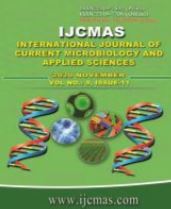


 National Academy of Agricultural Sciences (NAAS)
National Academy of Agricultural Sciences (NAAS)

|
PRINT ISSN : 2319-7692
Online ISSN : 2319-7706 Issues : 12 per year Publisher : Excellent Publishers Email : editorijcmas@gmail.com / submit@ijcmas.com Editor-in-chief: Dr.M.Prakash Index Copernicus ICV 2018: 95.39 NAAS RATING 2020: 5.38 |
The Knowledge of spatial-variability is critical for site specific nutrient management in soil fertility. Soil sample (149) were gotten from surface from 10 selected sites for preparing precise digital maps using point, line and polygon tools of the GIS (TNTmips 2010) software. Soil spatial variability typically defines variation in soil properties in surface soil such as fertility, pH, EC, soil organic carbon (OC), free CaCO3, mineralizable N,P2O5, K2O and S. In this study 149 soil samples were collected from the Rajendra Agricultural University, Pusa Farm, and based on the score of nutrients, corresponding thematic maps were drawn up. The thematic soil maps clearly revealed the distribution of different physico-chemical characteristics and available nutrients status which were assigned appropriate classes - low, medium and high or sufficient /deficient. The maximum spatial distribution of soil pH 8.0 to 8.5 (41.84%), soil EC 0.5 to 1 dS m-1 (49.31%), organic carbon 0.50 to 0.75% (60.43%), mineralizable soil nitrogen< 250 kg ha-1 ( 86.27%) , available phosphorus 25 to 50 kg ha-1 (71.06%), potassium 125 to 300 kg ha-1 (87.71%), available S < 13 mg kg-1 (80.48%) and Free CaCO3 20-30% (55.2 %). Under multi major nutrient deficient soils, low in nitrogen and potassium were in 36.74% area and low phosphorus and potassium were in 19.78% area. Nutrient Index calculated for the major nutrients N, P and K were 1.416, 1.893 and 1.678, respectively. Productivity Index (PI) was estimated on the basis of soil texture available N, P2O5 and K2O showed spatial distribution of 90.27 % area with low PI, 9.57% area with medium PI and 0.15 % with high PI.
 |
 |
 |
 |
 |